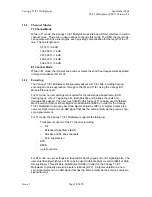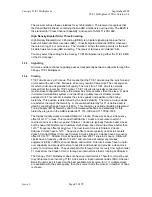
Canopy
T1/E1
Multiplexer
September
2004
T1/E1
Multiplexer
FPGA
Version
3.4
Page
23 of 73
Loss of Clock Signal
Should the Master port not be able to track the incoming T1/E1 bit stream due to a loss of
signal, then the unit will use the Secondary port as the clock source. Once the Master T1
recovers synchronization by locking onto the signal, the unit will revert to using the
Master port as the clock source.
Timing Modes
Each T1/E1 interface port that is in use must have clocking configured to avoid potential
frame slips. All T1/E1 interface ports have an identical global timing mode. There are two
timing modes for the Canopy T1/E1 Multiplexer, namely Loopback and Recovery modes.
Loopback mode: the T1/E1 Transmit clock (transmit from the Canopy T1/E1 Multiplexer)
is derived from the incoming Receive clock on the T1/E1.
Recovered mode: the T1/E1 Transmit clock (transmit from the Canopy T1/E1
Multiplexer) is derived from the far-end device’s transmit clock (the far end Canopy T1/E1
Multiplexer Receive clock). In this mode, a buffer is used to accommodate bursts of
Ethernet traffic. The buffer is, on average, maintained at a constant level. As the buffer
fills, the Transmit clock increases in frequency to avoid overflow. As the buffer empties,
the Transmit clock decreases in frequency in order to maintain a constant level.
Note: when the system is set to Recovered Timing Mode, the derived clock is
susceptible to Packet Delay Variation (PDV) and may not comply with jitter and wander
specifications.
Loopback Timing Mode
Loopback Timing Mode takes the incoming Transmit clock from a network device, such
as a PBX, and derives the clock signal from that device for the outgoing Receive clock
(PBX receive clock).
Figure 8: Master timing set to Loopback mode
Recovered Timing Mode
Recovered Timing Mode takes the incoming Ethernet bit stream from the BH link and
derives the clock signal from the incoming bit stream for the outgoing Receive clock (PBX
receive clock).
Issue
3
















































